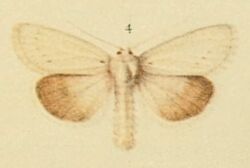Biology:Chortodes morrisii
| Chortodes morrisii | |
|---|---|

| |
| Form bondii | |
| Scientific classification | |
| Kingdom: | |
| Phylum: | |
| Class: | |
| Order: | |
| Family: | |
| Genus: | |
| Species: | C. morrisii
|
| Binomial name | |
| Chortodes morrisii (Dale, 1837)
| |
| Synonyms | |
| |
Chortodes morrisii, or Morris's wainscot, is a moth of the family Noctuidae.
It is found in western and southern Europe.[1][2][3] In Britain it is limited to Devon and Dorset, while the form bondii, previously occurring in Kent, is thought to be extinct.
Technical description and variation
A. morrisii Dale Larger than (Photedes extrema), chalk white, with faint grey dusting towards termen in the males; a curved series of black vein spots represents the outer line; no marginal spots; hindwing dark grey, paler in female; the fringe white; the abdomen is longer and thinner, the pectus and palpi smoother, less woolly, than in extrema.[4] The wingspan is 26–34 mm.[2]
Biology
The moth flies in June and July.
The larvae feed on stems of tall fescue (Festuca arundinacea).[5]
Subspecies
- Chortodes morrisii morrisii
- Chortodes morrisii sohnretheli (Püngeler, 1907) (Italy, named in honour of Otto Sohn-Rethel)
- Chortodes morrisii bondii (Knaggs, 1861) (named after Frederick Bond)
References
- ↑ Savela, Markku (13 May 2020). "Chortodes morrisii (Dale, 1837)". https://www.nic.funet.fi/pub/sci/bio/life/insecta/lepidoptera/ditrysia/noctuoidea/noctuidae/xyleninae/chortodes/#morrisii. Retrieved 12 August 2020.
- ↑ 2.0 2.1 Gustafsson, Bert (12 November 2009). "Photedes morrisii". http://www2.nrm.se/en/svenska_fjarilar/c/chortodes_morrisii.html. Retrieved 6 January 2013.
- ↑ Wall, Mike. "2346 Morris's Wainscot (Chortodes morrisii)". http://www.hantsmoths.org.uk/species/2346.php. Retrieved 6 January 2013.
- ↑ Warren, W. in Seitz, A. Ed., 1914 Die Großschmetterlinge der Erde, Verlag Alfred Kernen, Stuttgart Band 3: Abt. 1, Die Großschmetterlinge des palaearktischen Faunengebietes, Die palaearktischen eulenartigen Nachtfalter, 1914
 This article incorporates text from this source, which is in the public domain.
This article incorporates text from this source, which is in the public domain.
- ↑ Wikisource:The Moths of the British Isles/Chapter 15#301
Wikidata ☰ Q5105255 entry
 |

